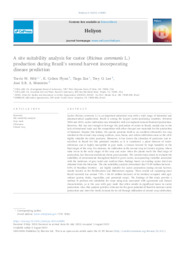A site suitability analysis for castor (Ricinus communis L.) production during Brazil's second harvest incorporating disease prediction.
A site suitability analysis for castor (Ricinus communis L.) production during Brazil's second harvest incorporating disease prediction.
Author(s): WITT, T. W.; FLYNN, K. C.; ZOZ, T.; LEE, T. O.; MONTEIRO, J. E. B. de A.
Summary: ABSTRACT. Castor (Ricinus communis L.) is an important industrial crop with a wide range of industrial and pharmaceutical applications. Brazil is among the largest castor-producing countries. Between 2004 and 2010, castor cultivation was stimulated with an emphasis towards biodiesel production. However, this was not enough to leverage the production of castor in Brazil, mainly due to the lack of structured trade and the competition with other cheaper raw materials for the production of biodiesel. Despite this failure, the species presents itself as an excellent alternative for crop rotation in the second crop among soybean, corn, beans, and cotton cultivation areas as the oil is highly valuable for other products. Moreover, it has drawn the attention of producers and researchers in Brazil for this potential rotation as it is considered a plant tolerant of waterdeficiency and is highly susceptible to gray mold, a disease favored by high humidity in the final stages of the crop. For instance, its cultivation in the second crop in Cerrado regions, where rains occur in the early stages of the crop and cease when the plants reach the final stage of production, has been successful and shows great promise. The current study aimed to evaluate the suitability of environments throughout Brazil to grow castor, incorporating variables associated with the incidence of gray mold and confirm these findings based on existing castor trial data obtained from the literature. The site suitability analysis determined that 74.99 million hectares - 8.8% of Brazilian territory - are highly suitable for castor production during second harvest, mostly located in the Northeastern and Midwestern regions. These results are surprising since Brazil currently has around 7.8% (~66.81 million hectares) of its territory occupied with agriculture (grains, fruits, vegetables, and perennial crops). The findings of this study provide a method to perform site suitability for crops using data associated with agronomic and disease characteristics, as is the case with gray mold that often results in significant losses in castor production. Also, this analysis provides evidence for the great potential of Brazil to increase castor production and meet the world demand for its oil through utilization of second-crop cultivation.
Publication year: 2023
Types of publication: Journal article
Observation
Some of Embrapa's publications are published as ePub files. To read them, use or download one of the following free software options to your computer or mobile device. Android: Google Play Books; IOS: iBooks; Windows and Linux: Calibre.
Access other publications
Access the Agricultural Research Database (BDPA) to consult Embrapa's full library collection and records.
Visit Embrapa Bookstore to purchase books and other publications sold by Embrapa.

